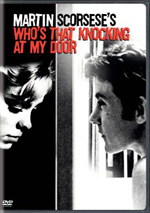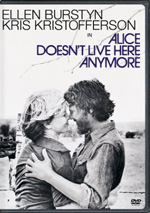|
WARNER
|

| |
|
MOVIE INFO
|
|
Director:
Martin Scorsese
Cast:
Zina Bethune, Harvey Keitel, Ann Collette, Lennard Kuras, Michael Scala, Harry Northup, Tsuai Yu-Lan, Saskia Holleman, Bill Minkin
Writing Credits:
Betzi Manoogian, Martin Scorsese
Synopsis:
For the movie world, a major talent was knocking: New York University graduate film student Martin Scorsese. Roger Ebert of the Chicago Sun-Times proclaimed Who's That Knocking at My Door to be "a great moment in American movies." Harvey Keitel plays J.R., an unemployed youth content to hang out with his buddies in New York's Little Italy. But love, in the person of a college-educated girl (Zina Bethune), soon throws J.R. into a turmoil that challenges his ways of looking at the neighborhood - and life itself. Scorsese went on to make such landmark films as Mean Streets, Taxi Driver, Raging Bull and GoodFellas. Each shows he's lost none of the fire and inventiveness seen here in his debut work.
Box Office:
Budget
$75 thousand.
MPAA:
Rated R
| |
|
DVD DETAILS
|
Presentation:
Widescreen 1.85:1/16x9
Audio:
English Monaural
Subtitles:
English
French
Spanish
Closed-captioned
Runtime: 90 min.
Price: $19.97
Release Date: 8/17/2004
Bonus:
Disc One
• Audio Commentary with Director Martin Scorsese and Directorial Assistant Mardik Martin
• “From the Classroom to the Streets: The Making of Who’s That Knocking At My Door” Documentary
| |
|
PURCHASE @ AMAZON.COM
|

| |
|
EQUIPMENT
|
Sony 36" WEGA KV-36FS12 Monitor; Sony DA333ES Processor/Receiver; Panasonic CV-50 DVD Player using component outputs; Michael Green Revolution Cinema 6i Speakers (all five); Sony SA-WM40 Subwoofer.
| |
|
RELATED REVIEWS
|

| |
[an error occurred while processing this directive]
|
Who's That Knocking At My Door? (1967)
|
|
Reviewed by Colin Jacobson (September 9, 2004)
Every filmmaker must start somewhere. For Martin Scorsese, his beginning as a feature film director started with 1968’s Who’s That Knocking On My Door, the story of a young man named JR (Harvey Keitel). We see him with his rough and tumble street-oriented friends Joey (Lennard Kuras) - the local loan shark - and Sally Gaga (Michael Scala), a not-so-bright kleptomaniac. As they wait for the Staten Island Ferry, JR meets “The Girl” (Zina Bethune) and the pair chat about movies.
Not much of a storyline ensues, as Door mainly follows JR’s life. The film alternates between his interactions with his male pals and his romantic involvement with the Girl. We see complications on both sides and follow the paths toward some form of conclusion.
That’s not much of a story, but Door offers an interesting slice of life. Many will disagree, but I find it more compelling than the rambling Mean Streets. To be sure, Door foreshadows Scorsese’s later signature use of music, and does so in interesting ways. For example, a bright doo-wop song creates an intriguing counterpoint to a rape sequence. Even in his cinematic infancy, Scorsese knew how to use pop songs to elicit a reaction, and this motif occurs a few times during Door, to good effect.
Door presents a surprisingly self-assured portrait of a certain lifestyle. Scorsese clearly goes for what he knows, and it seems clear that JR acts as a stand-in for the director to a degree. It’s not an autobiographical role, but more than a few elements appear based on Scorsese. The film boasts a sense of realism as Scorsese demonstrates a good feel for the subject and the characters.
Granted, the roles remain fairly thinly-developed, especially beyond JR. He gets reasonable exploration, but the others lack much dimensionality. I’m not sure why Scorsese didn’t bother to give The Girl a name, though this foreshadows the general anonymity of women in most of his films. Scorsese’s a man’s director and focuses on the male viewpoint heavily, and that dominates Door.
No one will mistake Door for Scorsese’s best work, and the director himself seems very down on it. However, despite some erratic execution, I think it succeeds surprisingly well. It acts like something of a precursor to his later material and sputters at times, but it comes across as surprisingly self-assured during a lot of it, and it remains quite interesting.
|
The DVD Grades: Picture C+/ Audio C/ Bonus B-
|
|
Who’s That Knocking At My Door appears in an aspect ratio of approximately 1.85:1 on this single-sided, double-layered DVD; the image has been enhanced for 16X9 televisions. An erratic picture, Door offered many very attractive sequences but also suffered from more than a few problems.
Sharpness mostly worked fine. Some interiors displayed moderately soft imagery, but in general, I noticed no problems with definition. The movie mostly came across as concise and detailed. I saw no signs of jagged edges or shimmering, and I also witnessed no edge enhancement.
Blacks varied a bit but usually seemed pretty deep and dense. Shadow detail followed suit, as most low-light shots were reasonably distinctive and visible. Grain interfered with those to some degree, though moderately excessive grain seemed inevitable given the flick’s cheap origins. The erratic light conditions also rendered some low-light shots somewhat tough to discern, but those remained the exceptions.
Print flaws created the majority of the issues. Various instances of specks, blotches, grit, marks, thin lines and scratches popped up throughout the movie. However, I need to note that they decreased as the movie progressed. The first act looked significantly dirtier than the rest of the flick, though sporadic defects still appeared. Ultimately this was a flawed but generally satisfying transfer that likely represented the source material about as well as possible.
The age and low budget of Door also affected its monaural soundtrack, which was mediocre but acceptable given those factors. Speech usually sounded somewhat dense and metallic. A few issues with intelligibility occasionally manifested themselves, but most of the lines remained understandable. Effects showed similar tones, as they appeared somewhat thick and boomy but were reasonably clean in general. As with many Scorsese films, Door featured no score and instead used various songs. These presented a lot of midrange without much dimensionality, and they seemed moderately clear and bright at best. Some noisiness interfered with the mix at times, usually connected to the recording of the speech. In the end, nothing about the audio of Door stood out as positive, but it failed to present too many negatives for a cheap recording from 1968.
When we head to the extras, we start with an audio commentary with director Martin Scorsese and directorial assistant Mardik Martin. Both were recorded separately for this edited, non-screen-specific piece. The commentary doesn’t fill the movie’s entire running time, as it skips some parts and lasts a total of 47 minutes and 47 seconds.
As with the other Scorsese Collection tracks, this one offers a great take on its subjects. Scorsese provides a discussion of his early career thoughts and what led him to film. He goes through student works and relates how he came to make Door. He also gives us some specifics about its creation, with insight into the various problems he experienced and also why he doesn’t much care for the flick. Martin chimes in less frequently, but he explores his own reasons for becoming a filmmaker as well as his collaboration with Scorsese. As always, it’s too brief, but it’s very lively and informative.
Next we get From the Classroom to the Streets: The Making of Who’s That Knocking At My Door. In this 12-minute and 35-second documentary, we get notes from Martin, who chats about his entry into the world of film, his first meeting with Scorsese, other titles, the actors, the flick’s development and changes that occurred along the way, locations, Scorsese’s preparation, the dialogue, and the reality behind the fiction. The discussion repeats some elements from the commentary, but it includes a fair amount of new information and fleshes out the topic.
For his first film, Martin Scorsese didn’t knock one out of the park, but Who’s That Knocking At My Door presents a fairly accomplished effort. The movie fails to become something particularly remarkable, but it shows evidence of the director’s talents at a young age. Picture and sound seem decent but average, while the smattering of extras gives us a moderately interesting look at the film’s background and creation. Not one of Scorsese’s best flicks, Door nonetheless seems intriguing, and it’s good enough for me to recommend it beyond the simple historical curiosity factor.
Note: Who’s That Knocking At My Door can be purchased on its own or as part of the Martin Scorsese Collection. The latter includes Door along with the new special editions of Mean Streets, Alice Doesn’t Live Here Anymore, GoodFellas and After Hours. Separately, those five retail for $106.87, but the Collection goes for a mere $59.92. That makes it a real steal for Scorsese fans.
|
|
Viewer Film Ratings: 3.7142 Stars | Number of Votes: 7 |
|
|

